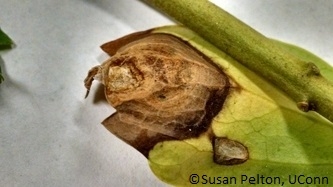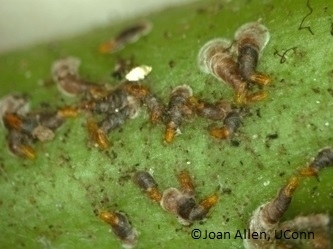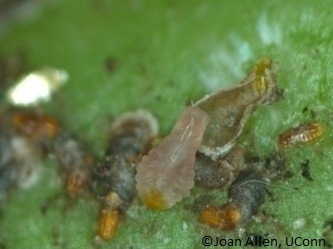Leaf and stem blight, a destructive disease of pachysandra, is caused by the fungus Volutella pachysandrae. Both the leaves and stems of pachysandra are attacked by this fungus. Brown blotches on the leaves are usually the first noticeable symptoms. The blotches gradually increase in size until the entire leaf turns brown or black and dies.


In severe infections, stem cankers (browning of the stem at the terminal, mid-stem or ground level) occur and will cause the plant to wither, turn brown or black and die. During wet weather, affected parts are often covered by reddish-orange cushion-like fruiting structures of the fungus. These structures, called spores, allow the disease to spread throughout the planting. Plants die in patches, and the disease commonly produces a circular pattern in the bed.
Disease spread is most rapid in dense overcrowded plantings and in plantings weakened by drought, winter injury, sun scold or attacks by insects. Use of a damp, heavy mulch which holds excessive moisture also encourages disease development.
Control
For a new bed, select only healthy, high quality plants. Do not plant Pachysandra where conditions are constantly moist. Thin thick plantings to increase light and air circulation. In established infected beds remove all severely diseased plants. Prune out infected stems of other plants. Pruning should be done during dry weather to minimize the spread of the fungus. All diseased plant material should be burned or sent away in the trash. Larger beds of pachysandra may be mowed at the highest level and the clippings should be bagged and trashed. Disinfect pruners or mower blades in 70% rubbing alcohol after use. Plants may be protected with a fungicide. Spray the plants two or three times at 10 to 14 day intervals.
If Volutella blight has been a problem in the past, it may be necessary to protect plants with two or three fungicide applications beginning when new growth starts each year. Avoid heavy, thick mulches of materials, such as leaves or compost which hold moisture and favor the establishment of the disease. If mulching is needed on new plantings, large pine bark chips could be used. Remove fallen leaves in the autumn to avoid prolonged moisture exposure.
The disease spreads rapidly in stands that have been weakened by insects such as Euonymus scale and root knot nematodes so an attempt should be made to control them. Scale insects, particularly euonymus scale, can be very destructive. For control of scale, prune badly infested plants. Horticultural oil can be applied in mid-April to early May. If coverage is good, excellent control can be achieved.

Euonymus scale

Scale body with hard cover removed
Despite good cultural practices, pests and diseases at times may appear. Chemical control should be used only after all other methods have failed.
For pesticide information or other questions please call toll free: 877-486-6271.
Revised by UConn Home and Garden Education Center 2016.